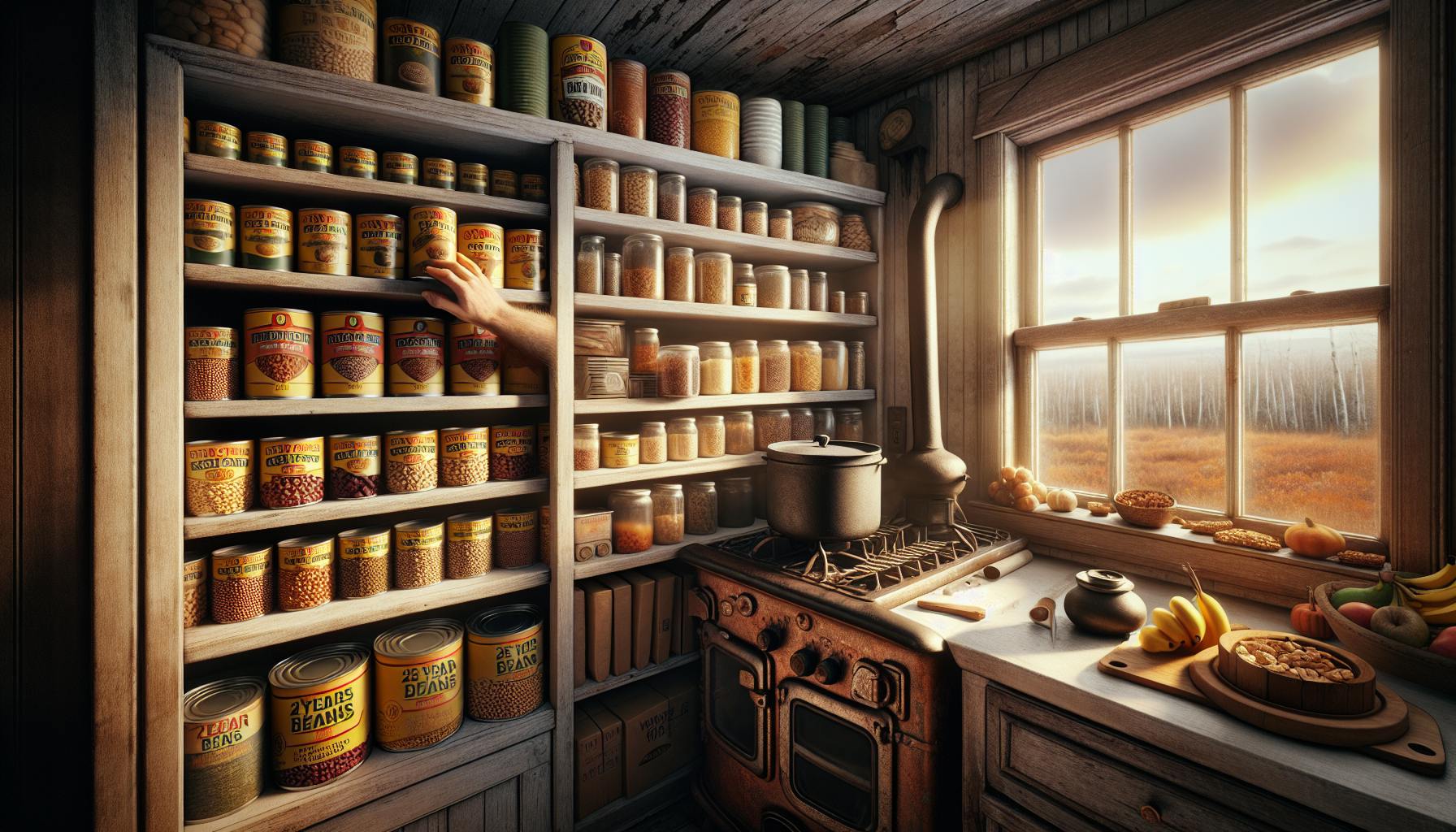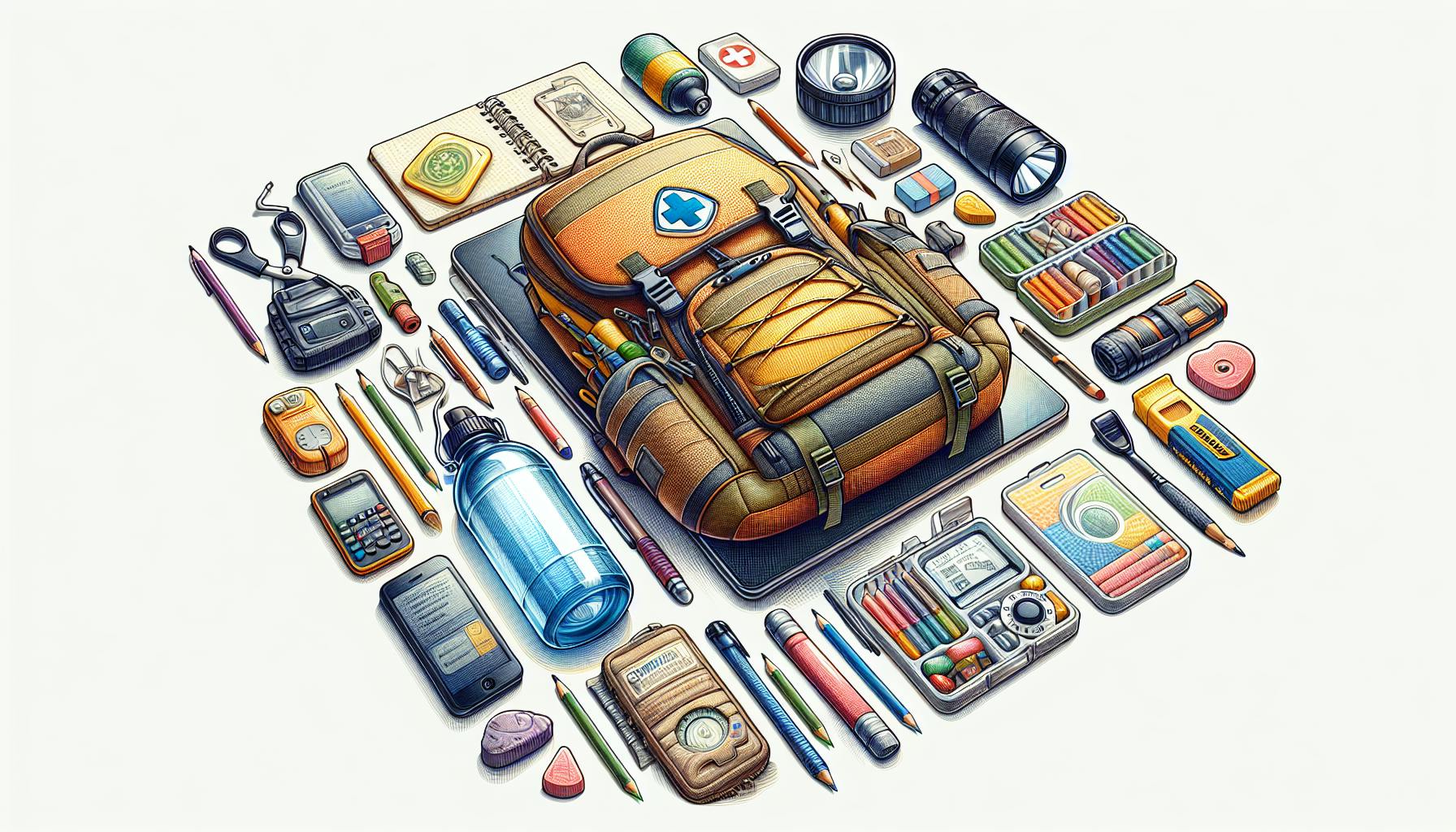Preparing for emergencies is crucial, but building an adequate survivor food kit can be complicated.
This guide provides personalized guidance on assembling a survivor food kit that meets your family's unique dietary needs and preferences within your budget.
You'll learn how to calculate sufficient calories accounting for health conditions, taste preferences and family size, choose the right nutrient-dense foods and supplies, estimate needed quantities based on consumption, explore budget-friendly options, and properly store your supply to maximize shelf life.
Introduction to Building a Survivor Food Kit
A survivor food kit is an essential part of emergency preparedness. It contains non-perishable food and supplies to sustain you and your family during a crisis when access to normal food sources is disrupted.
When assembling your survivor food kit, tailor it to meet your household's unique needs and restrictions. First, make an inventory of any dietary limitations, food allergies, or religious restrictions in your family. This will help you choose suitable foods and avoid any ingredients that could cause illness.
Next, factor in your budget. Emergency food kits can range widely in price, but you don't need to break the bank to put together a nutritious supply. Opt for shelf-stable basics like rice, beans, canned meat and vegetables. Augment with comfort foods like trail mixes, jerky, or freeze-dried meal pouches.
Finally, make sure to size your food kit appropriately for your household. Experts recommend storing at least a 3-day supply, but consider your family size and individual calorie needs. Aim for ~2,000 calories per person per day. Kits sized for a family of 4-6 are readily available from many prepper brands.
Customizing your survivor food kit ensures you have an adequate emergency food supply tailored to your family's unique dietary needs, restrictions, tastes and budget. Continue reading for tips on storage and supplementation.
Assessing Your Family's Unique Needs
Considering each family member's specific dietary needs and restrictions is crucial when assembling a well-stocked survival food kit. Make a detailed list of any food allergies, intolerances, medical conditions, religious restrictions, and personal preferences within your household. For example, document nut or gluten allergies, vegetarian diets, diabetes dietary guidelines, etc.
Listing Any Dietary Restrictions
- Carefully record any food allergies or intolerances your family members may have, such as dairy, eggs, tree nuts, peanuts, wheat/gluten, soy, fish, shellfish.
- Note religious, ethical or personal lifestyle food restrictions in your family, like kosher, halal, vegan, vegetarian diets.
- List any low-sodium or low-sugar needs for family members with hypertension, diabetes or weight management goals.
Considering Health Conditions
- Consult healthcare providers about tailoring food choices to accommodate chronic medical conditions like diabetes, hypertension, autoimmune disorders, kidney disease, etc.
- For food sensitivities like lactose intolerance, keep digestive aids like Lactaid or enzymes in medical kit.
- Check that ingredients don't interact with medications family members may take.
Accounting for Taste Preferences
- Within nutritional guidelines, try to stock foods your family enjoys, for comfort and mental health. But don't rely solely on junk comfort foods without nutrients.
- Get input from family members so kit doesn't just reflect one person's preferences.
- Balance health needs with some flexibility for treats to boost morale in stressful times.
Calculating Sufficient Calories
- Nutrition experts recommend stockpiling at least 2,000 calories per person, per day.
- Calculate needs based on each family member's age, biological sex, activity level, and any special health considerations.
- Consider a larger surplus for teenagers, pregnant/nursing women, and very active family members.
Planning for a Family of 5: Survival Food Kits
To adequately feed a family of 5, customize your survival food kit to the demographics of your household. Calculate the total target calories per day based on having 3 adults, 2 kids. For example:
- Adult #1 (female, moderately active): 2,200 calories
- Adult #2 (male, very active): 3,000 calories
- Adult #3 (female, sedentary): 1,800 calories
- Child #1 (teen male): 2,800 calories
- Child #2 (young girl): 1,600 calories
Total target: 11,400 calories per day
With this target in mind, stock enough emergency food for your family size and activity levels. Plan for extra rations like high-protein bars, dehydrated fruit, and nutrient-dense MREs to cover all your bases.
Selecting the Right Foods and Supplies
When building your survivor food kit, it's important to focus on non-perishable items with long shelf lives that will meet your nutritional needs in an emergency. Though comfort foods can provide a mental boost, the bulk of your food supply should consist of nutrient-dense options to support health.
Choosing Nutrient-Dense Foods
Prioritize non-perishable foods that pack nutritional value, including:
- Canned or dried beans, lentils, vegetables, and fruits
- Whole grains like oats, brown rice, quinoa
- Nut butters like peanut or almond butter
- Nuts and trail mixes
- Whole-grain crackers and cereal
- Canned fish like salmon, sardines, or tuna
These foods provide protein, healthy fats, fiber, vitamins, and minerals to maintain energy levels in stressful situations.
Incorporating Some Comfort Items
While nutrition is key, allowing for some comfort foods in moderation can be good for mental health. Some options include:
- Honey, maple syrup, or other natural sweeteners
- Chocolate or candy bars
- Crackers, pretzels, potato chips
- Powdered drink mixes like hot chocolate or apple cider
Just be mindful that these should supplement your nutritional needs instead of replacing more vital supplies. Limit sweets and salty snacks to small quantities.
Considering Food Sensitivities
When stocking up, be aware of common food allergens like wheat, dairy, soy, eggs, and tree nuts. Thoroughly check labels and ingredients of any pre-packaged survival food kits to ensure they meet your dietary needs. Some allergen-free options include:
- Canned fruits and vegetables
- Rice, quinoa, buckwheat or corn-based products
- Nut-free trail mixes with seeds and dried fruit
- Canned chicken, salmon, sardines instead of peanut butter
Making accommodations allows everyone in your family to safely utilize your emergency food supplies.
Opting for a 25-Year Emergency Food Supply
For long-term preparedness, consider investing in a 25-year emergency food kit that includes freeze-dried or dehydrated meals with decades-long shelf lives. These kits are more expensive upfront but allow you to buy in bulk for the long haul. When shopping, calculate supply needs based on one adult's recommended daily caloric intake, then scale up proportionately for additional family members. This ensures you have ample reserves to withstand a long-term crisis.
Estimating Needed Quantities
To determine the amount of food you need for your survivor food kit, first calculate your family's total daily calorie needs. As a general estimate, plan for 2,000 calories per person. So for a family of 4, that would be 8,000 calories per day.
Next, multiply this by the number of days you want your food supply to last - a common benchmark is 30 days. So for a 30 day supply for a family of 4, you'd need 240,000 calories total (8,000 calories x 30 days).
When buying survival food like freeze dried meals or MREs, carefully read nutrition labels to understand calorie counts, protein content, etc. Compare across brands to maximize nutrition. On average, plan for 1,200 - 1,800 calories per day's worth of food.
If your food supply relies on water for preparation, make sure to stock additional water. Understand if heat or fuel is required for cooking as well.
For a family of 4 planning for 30 days, a well-rounded food kit would have:
- 100 freeze dried breakfasts (with milk and fruit)
- 100 freeze dried entrees
- 100 freeze dried vegetables
- 30 pouches of rice/grains
- Nut butters, jerky, granola bars for snacking
This mix provides nutrition, calories, and variety to sustain energy and health during an extended crisis. Adjust quantities based on your family's size and needs.
sbb-itb-b932644
Budgeting and Selecting Kits
When building your survivor food kit, it's important to consider your budget but also invest sufficiently to ensure you have quality nutrition. You'll need to compare pre-made kits from reputable brands or customize your own supplies.
Evaluating Pre-Made and Custom Kits
Pre-made kits from companies like Mountain House and Wise Foods can provide convenience, but customizing your own kit allows you to tailor it to your family's specific needs and preferences. Consider food allergies, storage space, budget, and types of food your family enjoys.
Establishing a Reasonable Budget
Expect to invest at least $100-500 for a 1 month supply of food depending on your family size and the specific food items you choose. Prioritize nutritious, non-perishable foods. Consider building your supply gradually over time.
Identifying Best Value Options
Opt for affordable staples like rice, beans, oats, and peanut butter purchased in bulk quantities. These provide nutrients and calories at a reasonable cost. Supplement with some pre-packaged meals for convenience.
Exploring Survivor Food Kit for Sale
Research sites like Amazon, specialty prepper retailers, and wholesalers to find survivor food kits for sale that fit your budget and contain items your family will eat. Read reviews and compare nutritional information.
Finding the Best Survivor Food Kit
The best kit provides comprehensive, nutritious food at a reasonable price. Ensure it includes sufficient calories, macros, and vitamins to sustain energy and health. Prioritize variety, shelf-life, quality, taste, and budget. The optimal kit is personalized for your situation.
Storing Your Food Supply Properly
Properly storing your emergency food supply is crucial to ensuring it lasts as long as possible. Here are some key tips for maximizing shelf life:
Following Recommended Storage Tips
- Store foods in a cool, dry, dark place like a basement or interior closet. Temperature and light can reduce shelf life.
- Keep items in airtight containers or oxygen absorbers to prevent moisture and pests.
- Once opened, refrigerate or freeze perishable foods. Follow package guidance on ideal storage methods.
Rotating Stock
- Use a first in, first out (FIFO) system to cycle older foods out.
- Try to use foods before expiration and replace what you eat with new stock. An inventory can help track usage.
Maintaining an Inventory
- Keep a detailed list of all survival foods, purchase dates, expiration dates, storage locations.
- Update when items are opened or used up. Helps ensure nothing expires before being utilized.
### Maximizing Shelf Life with Mountain House Emergency Food Supply * Mountain House pouches and buckets have a shelf life of over 25 years when stored properly.
- They use advanced freeze drying and packaging methods to preserve nutrients and taste.
- Follow guidance to store unopened pouches in a cool, dry place and maximize longevity.
Proper storage and rotation of your emergency food supply allows it to last for years while remaining safe to eat. An inventory system helps you track usage and replenish items on time.
Online Shopping for Your Survivor Food Kit
Leveraging online marketplaces can make assembling your survivor food kit more convenient. With just a few clicks, you can browse and compare a wide selection of emergency food kits tailored to different budgets and dietary needs.
Navigating Survivor Food Kit Amazon Options
Amazon offers an extensive range of survivor food kits to choose from. Here are some tips for finding the right one:
-
Use the search filters to narrow down kits based on number of people, calories per day, shelf life, and average rating. This makes comparison easier.
-
Read through customer reviews carefully, especially the critical ones. See what issues people faced with a particular kit to determine if it meets your needs.
-
Compare the nutritional information across brands. If you have dietary restrictions, ensure the food options accommodate them.
-
Pay attention to content quantity. Having sufficient calories and nutrients for your family is vital. Crunch the numbers per person.
-
Consider bundle deals with water pouches or cooking equipment included if you lack survival gear. This provides cost savings too.
-
Choose kits with at least a 5 year shelf life for optimal emergency preparedness. The longer the better.
Taking the time to research on Amazon helps you discover the best survivor food kit for your situation. Comparing content, shelf life, ratings, and price facilitates an informed decision.
Key Takeaways on Building Your Own Survivor Food Kit
Building your own customized survivor food kit takes research and planning, but is an important step in emergency preparedness. Here are some key takeaways:
-
Assess your family's dietary needs and restrictions to determine the best food items to include. Consider allergies, health conditions, ages of family members, etc.
-
Research and compare different food brands and kits. Look at nutritional content, shelf life, packaging, and cost. Quality brands like Mountain House and Wise Foods are good options.
-
Determine the right quantity by considering your family size and projected duration of emergency. Kits for a family of 4 for 3-6 months is a good benchmark.
-
Store items properly in a cool, dark, dry place to maximize shelf life. Use airtight containers, oxygen absorbers, etc.
-
Organize by food groups and label containers clearly for easy access. Group like items together.
-
Budget accordingly and take advantage of sales and deals. Building over time can make financial sense.
-
Include utensils, a can opener, and other tools for food preparation and cooking when possible.
-
Rotate and replace food every 6-12 months to keep supplies fresh and current. Mark purchase dates clearly.
Customizing your survival food supply takes effort but ensures your family's dietary needs are met in an emergency. Follow these tips for the best results. Let us know in the comments if you have any other tips!


